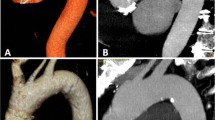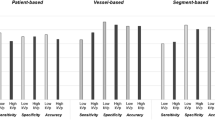Abstract
The purpose of this study was to investigate the effects of a prospective ECG-gated, low kilovoltage and low mAs protocol on image quality and radiation dose when acquiring CT angiography of the thoracic aorta (CTTA). Sixty patients with a body mass index (BMI) of less than 30 and a heart rate of less than 100 beats per minute (bpm) were included in the study. Thirty consecutive patients were examined with retrospective ECG-gating and standard parameters (group A) (120 kVp, 340 reference effective mAs).The next thirty (group B) were examined with prospective ECG-gating, 100 kVp and 170 mAs. Quantitative analysis included measurements of image resolution of the thoracic aorta at three levels, mean attenuation in the aorta and signal to noise ratio (SNR). Qualitative analysis assessed image artifact and graded image quality on five point scales. Effective radiation doses were estimated. The radiation dose of group A was 26.2 ± 6.0 mSv (mean ± standard deviation). For group B it was 2.9 ± 0.5 mSv (P < 0.001). Mean aortic attenuation was significantly higher in group B than group A (487 ± 100 Hu and 372 ± 74 Hu) (P < 0.01).SNR was significantly higher in group A (21.7 ± 5.7 compared to 14.5 ± 5.3) (P < 0.01). Image resolution was significantly higher in group B at all measured anatomical levels (P < 0.01). There was no significant difference in the final subjective scores between group A and group B (Mann–Whitney U = 438, P = 0.79). High quality low dose CTTA is clinically achievable, in patients with a BMI less than 30 and a heart rate less than 100 bpm, using a prospective ECG-gated, low kilovoltage, low mAs technique.



Similar content being viewed by others
References
Keane MG, Wiegers SE, Plappert T et al (2000) Bicuspid aortic valves are associated with aortic dilatation out of proportion to coexistent valvular lesions. Circulation 102(suppl):III35–III39
Davies RR, Kaple RK, Mandapati D et al (2007) Natural history of ascending aortic aneurysms in the setting of an unreplaced bicuspid aortic valve. Ann Thorac Surg 83:1400–1405
Chiles C, Carr JJ (2005) Vascular diseases of the thorax: evaluation with multidetector CT. Radiol Clin North Am 43:543–569
Quanadli SD, El Hajjam M, Mesurolle B et al (1999) Motion artifacts of the aorta simulating aortic dissection on spiral CT. J Comput Assist Tomogr 23:1–6
Loubeyre P, Angelie E, Grozel F et al (1997) Spiral CT artifact that simulated aortic dissection: image reconstruction with the use of 180° and 360° linear-interpolation algorithms. Radiology 205:153–157
Fleischman D, Rubin GD, Paik DS et al (2000) Stair-step artifacts with single versus multiple detector-row helical CT. Radiology 216:185–196
Batra P, Bigoni B, Manning J et al (2000) Pitfalls in the diagnosis of thoracic aortic dissection at CT angiography. Radiographics 20:309–320
Ko SF, Hseih MJ, Chen MC et al (2005) Effects of heart rate on motion artifacts of the aorta on non-ECG-assisted 0.5-sec thoracic MDCT. AJR Am J Roentenol 184:1225–1230
Roos J, Willmann J, Weishaupt D et al (2002) Thoracic aorta: motion artifact reduction with retrospective and prospective electrocardiography-assisted multi-detector row CT. Radiology 222:271–277
Van Prehn A, Vincken KL, Muhs BE et al (2007) Toward endografting of the ascending aorta: insight into the dynamics using dynamic cine-CTA. J Endovasc Ther 14:551–560
Van Prehn A, Bartels LW, Mestres G et al (2009) Dynamic aortic changes in patients with thoracic aortic aneurysms evaluated with electrocardiography-triggered computed tomographic angiography before and after thoracic endovascular aneurysm repair: preliminary results. Ann Vasc Surg 23(3):291–297
Ohnesorge B, Flohr T, Becker C et al (2000) Cardiac imaging by means of electrocardiographically gated multisection spiral CT: initial experience. Radiology 2:564–571
Nieman K, Oudkerk M, Rensing B et al (2001) Coronary-angiography with multi-sliced computed tomography. Lancet 357:599–603
Stolzmann P, Leschka S, Scheffel H et al (2008) Dual-source CT in Step-and-Shoot mode: noninvasive coronary angiography with low radiation dose. Radiology 249:71–80
Schertler T, Glucker S, Wildermuth S et al (2005) Comparison of retrospectively ECG-gated and non-gated MDCT of the chest in an emergency setting regarding workflow, image quality and diagnostic certainty. Emerg Radiol 12:19–29
Hausleiter J, Meyer T, Hadamitzky M et al (2006) Radiation dose estimates from cardiac multislice computed tomography in daily practice: impact of different scanning protocols on effective dose estimates. Circulation 113:1305–1310
Bischoff B, Hein F, Meyer T et al (2009) Impact of a reduced tube voltage on CT angiography and radiation dose. Results of the PROTECTION 1 study. J Am Coll Cardiol Img 2:940–946
Fleischmann D (2003) Use of high-concentration contrast media in multiple-detector-row CT: principles and rationale. Eur Radiol 13(suppl 5):M14–M20
Carr JC, Ma J, Desphande V et al (2002) High-resolution breath-hold contrast-enhanced MR angiography of the entire carotid circulation. AJR Am J Roentenol 178:543–549
Groves EM, Bireley W, Dill K et al (2007) Quantitative analysis of ECG-gated high-resolution contrast-enhanced MR angiography of the thoracic aorta. AJR Am J Roentenol 188:522–528
McCollough CH, Primak AN, Saba O et al (2007) Dose performance of a 64-channel dual-source CT scanner. Radiology 243:775–784
Menzel H, Schibilla H, Teunen D (eds) (2000) European guidelines on quality criteria for computed tomography. Publication no. EUR 16262 EN. European Comission, Luxembourg
Gerber TC, Kuzo RS, Morin RL (2002) Techniques and parameters for estimating radiation exposure and dose in cardiac computed tomography. Int J Cardiovasc Imaging 21:165–176
Morin RL (1998) Monte Carlo simulation in the radiological sciences. CRC, Boca Raton
Davies RR, Goldstein LJ, Coady MA et al (2002) Yearly rupture or dissection rates for thoracic aortic aneurysms: simple prediction based on size. Ann Thorac Surg 73:17–27
Ergin MA, Spievogel D, Apaydin A et al (1999) Surgical treatment of the dilated ascending aorta: when and how? Ann Thorac Surg 67:1834–1839
Brenner DJ, Hall EJ (2007) Computed tomography-An increasing source of radiation exposure. N Engl J Med 357:2277–2284
Preston DL, Ron E, Tokuoka S et al (2007) Solid cancer incidence in atomic bomb survivors: 1958–1998. Radiat Res 168:1–64
Cardis E, Vrijheid M, Blettner M et al (2007) The 15-country collaborative study of cancer risk among radiation workers in the nuclear industry: estimates of radiation-related cancer risks. Radiat Res 167:396–416
Fazel R, Krumholz HM, Wang Y et al (2009) Exposure to low-Dose ionizing radiation from medical imaging procedures. N Engl J Med 361:849–857
Wintersberger B, Jakobs T, Herzog P et al (2005) Aorto-iliac multidetector-row CT angiography with low kV settings: improved vessel enhancement and simultaneous reduction of radiation dose. Eur Radiol 15:334–341
Leschka S, Stolzmann P, Schmid FT et al (2008) Low Kilovoltage cardiac dual-source CT: attenuation, noise and radiation dose. Eur Radiol 18:1809–1817
Blanke P, Bulla S, Baumann T et al (2010) Thoracic aorta: prospective electrocardiographically triggered CT angiography with dual-source CT-feasibility, image quality, and dose reduction. Radiology 255:207–217
Ioana Mastora I, Martine Remy-Jardin M, Valérie Delannoy V et al (2004) Multi–detector row spiral CT angiography of the thoracic outlet: dose reduction with anatomically adapted online tube current modulation and preset dose savings. Radiology 230:116–1241
Primak AN, McCollough CH, Bruesewitzm MR et al (2006) Relationship between noise, dose and pitch in cardiac multi-detector row CT. Radiographics 26:1785–1794
Mollet NR, Cademartiri F, van Mieghem CA et al (2005) High-resolution spiral computed tomography coronary angiography in patients referred for diagnostic conventional coronary angiography. Circulation 112:2318–2323
Leschka S, Scheffel H, Desbiolles L et al (2007) Image quality and reconstruction intervals of dual-source CT coronary angiography: recommendations for ECG-pulsing windowing. Invest Radiol 42:543–549
Kelly DM, Hasegawa I, Borders R et al (2003) High-resolution CT using MDCT: Comparison of degree of motion artifact between volumetric and axial methods. AJR Am J Roentenol 182:757–759
Petersilka M, Bruder H, Krauss B et al (2005) Technical principles of dual source CT. Eur Radiol 68:362–368
Conflicts of interest
None.
Author information
Authors and Affiliations
Corresponding author
Rights and permissions
About this article
Cite this article
Farrelly, C., Davarpanah, A., Keeling, A.N. et al. Low dose dual-source CT angiography of the thoracic aorta. Int J Cardiovasc Imaging 27, 1025–1034 (2011). https://doi.org/10.1007/s10554-010-9742-9
Received:
Accepted:
Published:
Issue Date:
DOI: https://doi.org/10.1007/s10554-010-9742-9




